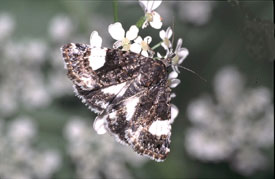
Four-spotted Moth. Photo by permission
of David Green/Butterfly Conservation |
The Linear Park is also the
home of the Four-spotted Moth (Tyta luctuosa), which is a nationally
rare insect. This moth is a grassland species that is typically
found on south facing banks on well-drained soils with sparse vegetation
and /or bare earth - a description that certainly fits the more
south-easterly end of the 'Walk'. The caterpillar feeds on field
bindweed, (Convolvulus arvensis) initially preferring the flowers
and the seeds, whilst the moth spends much of its active time visiting
flowers for nectar and appears to be particularly attracted to the
ox-eye daisy. Both these plants can be found along the 'Walk', the
former in abundance, so that all in all it seems a perfect habitat
for a moth for which, although it was formerly widespread and fairly
common in England, the number of recorded sightings has massively
declined since the 1930s.
This moth has been recorded
in every country in Europe except Ireland and Norway and the range
of its distribution extends eastwards to western Siberia and as
far south as Morocco. In the pre 1930s it was common in England
south of a line from Norfolk to Somerset so that Nottinghamshire
was always at the northerly edge of its range. Recently, apart from
sightings in Bingham it has only been sighted in eleven counties
in the south of England, chiefly on limestone grassland or in the
Breckland. The Four-spotted appears in May and June and there is
often a second generation in August or September. It is a very active
insect on the wing during sunny periods. If the sun is intermittent
the moths may still be found resting on flowers until the sun reappears.
If the weather is dull and cool or very windy the moths may not
fly up from the grass even if disturbed. The reasons for its decline
and the loss of colonies include the encroachment of shading trees
and other vegetation on the habitat and breeding grounds, together
with the intensification of agricultural methods over time. Because
of the significant decline in distribution in this country this
moth has a Great Britain classification as Vulnerable and is one
of fifty-three moths listed as a priority for attention in the UK
Biodiversity Action Plan, (BAP). Special management actions are
being recommended nationally to attempt to halt this decline and
to restore its numbers. The main objective of this, of course, is
to ensure, wherever possible, that occupied and nearby potential
habitats are appropriately managed. |
![]()


